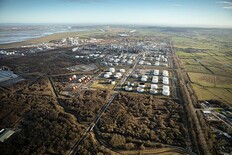- Essar is investing £1 billion in energy efficiency, fuel-switching, and carbon capture by 2030.
- The £360 million carbon capture plant at Stanlow will be completed by 2027.
- Kent plc has a pre-FEED engineering contract for the facility.
- The plant will sequester CO2 into depleted gas fields in Liverpool Bay.

Investment and Decarbonization Strategy
Essar Oil UK plans to build a £360 million carbon capture plant at its Stanlow refinery, aiming to become a leading low carbon refinery by 2030. This is part of a broader £1 billion investment in energy efficiency, fuel-switching, and carbon capture initiatives to significantly decarbonize its production processes.
Key Projects and Partnerships
Essar's strategy includes running core refining processes efficiently, decarbonizing operations, building a hydrogen future through Vertex Hydrogen and the HyNet consortium, developing green fuels, and establishing the UK's largest biofuels storage facility. The company will achieve its targets through incremental improvements and transformational projects, including the new carbon capture plant and significant investments in hydrogen and biofuels.
Carbon Capture Plant Details
Kent plc has been awarded a pre-FEED engineering contract to develop the facility, which will capture CO2 from one of Europe's largest full-Residue Fluidised Catalytic Cracking units at Stanlow. The captured gas will be sequestered into depleted gas fields under Liverpool Bay as part of the HyNet cluster infrastructure. The plant, expected to be completed by 2027, will eliminate an estimated 0.81 million tons of CO2 per year, equivalent to removing 400,000 cars from the road and nearly 40% of Stanlow's emissions.
Hydrogen Initiatives
Essar has signed a 'Heads of Terms' offtake agreement with Vertex for the supply of over 280MW of hydrogen to decarbonize its production facilities, including a new £45 million hydrogen-powered furnace. Vertex is developing the UK's first large-scale low carbon hydrogen production hub, expected to produce 1GW of hydrogen initially and capture 1.8 million tonnes of carbon annually. By 2030, Vertex aims to deliver nearly 4GW of low carbon hydrogen, meeting around 40% of the UK Government's national target.
